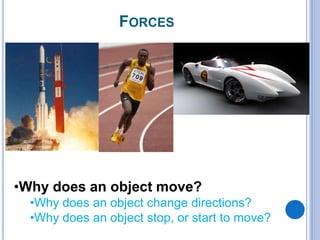
Forces notes 2010
- 1. FORCES •Why does an object move? •Why does an object change directions? •Why does an object stop, or start to move?
- 2. WHAT IS A FORCE? Force- push or pull. Described by magnitude (strength) and direction Measured in Newtons (N)
- 3. FORCES When forces are exerted in the same direction the two forces are added. 6N+3N=9N
- 4. FORCES IN OPPOSITE DIRECTIONS When forces are exerted in the opposite directions one force is given a + number the other is given a – number, and these numbers are added.
- 6. UNBALANCED FORCE When one force is greater in magnitude than the other it creates an unbalanced force. This is what causes objects to move, stop, and change directions.
- 7. + = Force 1 + Force 2 = Net Force UNBALANCED FORCE 1 direction
- 8. NALANCED FORCES CHANGE THE MOTION OF AN OBJECT Unbalanced Forces change the motion of an object
- 9. BALANCED FORCE When both forces are equal in magnitude and in opposite directions it creates a balanced force. The net force will then be equal to 0. No movement occurs. I bet this guy hopes the forces stay balanced!!
- 10. + = 0 2 forces cancel each other BALANCED FORCES
- 12. + = What about this force? ?
- 14. Describe the balanced and unbalanced forces in this given situation
- 15. THE MOVEMENT OF A CAR What are the forces working on this car? What other two forces are missing?
- 16. BIG IDEAS •There are forces that exist in nature that create movement and allow objects to become stationary. • Without forces, we would have mayhem.
- 17. Book sliding to the left
- 18. SPEED AND FORCES
- 19. Name of Force Definition Examples Gravity Gravity is a force that attracts bodies of matter toward each other. It is a force that is everywhere there is matter The size of the force depends on two factors: mass and distance -Force of attraction increases as mass increases -Force of attraction increases as distance decreases Keeps the planets in orbit around the sun, moon in orbit around the earth Holds us to the earth's surface. Weight is a measure of the force of gravity on your mass Is responsible for the tides. Causes acceleration of a falling object Responsible for air and water pressure (weight of air and water!) Surface Tension Liquid molecules are attracted to each other (some more than others!) Attraction between molecules causes a “membrane” to form on the surface of liquids Allows small insects to walk on water Mosquitoes “attach” eggs to surface of water Soap, kerosene, can “break” the surface tension Blowing bubbles – stretching surface tension
- 21. Magnetic An invisible force felt within the space around a magnet. This space, called the magnetic field, can either attract (pull) or repel (push away) other magnets and some types of metal. All magnets have two poles. These poles are opposites and are called the north and south poles. Opposite poles attract, while like poles, repel. Compasses work because of Earth’s magnetic field Iron and Nickel can be magnetized - Other metals cannot Magnets can be made with electricity.
- 22. Electrical A force between two charged particles Opposite charges attract, while like charges repel. The size of the force depends on two factors: size of charge and distance of objects -Force of attraction/repulsion increases as the size of the charge increases -Force of attraction/repulsion increases as distance decreases Static Electricity caused by touching or rubbing of two surfaces which causes buildup of charges Walking across carpet – you gain electrons which are released when you touch a doorknob (attracted because it is more +)!
- 23. Turning Force causes an object in uniform circular motion to move toward the center of the circular path. a car making a turn the movement of a roller coaster When you are riding in a car and the car accelerates, your body tends to move backward against the seat. Likewise, if the car stops suddenly, your body tends to move forward, in the direction of the dashboard
- 24. Buoyant Force (Upthrust) Force equal to the weight of the fluid (liquid or gas!) that is displaced by the object. Determined by an object’s DENSITY (mass ÷ volume!) An object will float if Density of Object < Density of Fluid Equal to the weight of the fluid (liquid or gas!) that is displaced by the object Explains why ships don’t sink Why we only see about 10% of icebergs (“tip of the iceburg”) Friction A force that acts in a direction opposite to the motion of a moving object. Friction will cause a moving object to slow down and finally stop Dependent on two factors -How hard surfaces are pushed together -The materials of which the surfaces are made Sliding friction – when solid objects slide over one another Rolling Friction – produced by wheels, ball bearings, etc Fluid (liquid or gas!) Friction – when an object moves through a fluid Lubricants reduce friction